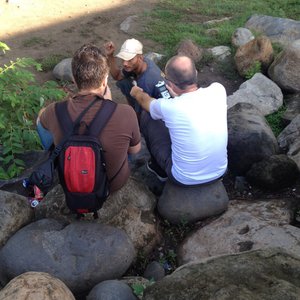
Manuel Ureste, Conrad Fox and Francisco Rodriguez de Leon reporting from Mexico
Tapachula, a working class town near the Mexican border with Guatemala, is best known for the thousands of Central American migrants who pass through every year on their way to the US, and gangs and notoriously abusive migration officials who plague the route. But an growing number of migrants from Africa and Asia are coming this way too, and for them, Tapachula is a haven of sorts. The city's 8th avenue has become an unlikely cosmopolitan hotspot, with signs in a variety languages, restaurants serving curry, and cyber cafes and hotels taking travel documents as collateral from those awaiting money orders. Few plan on staying more than a week before heading to the US, but most say that after months of perilous travel through South America, crossing into Mexico is "like a dream come true."

Sept. 14, 2015
Up to half a million Central Americans cross through Mexico to reach the United States every year. The trek has always been dangerous, and since Mexico began cracking down on migrants last year, the risks have increased. But Central American migrants are increasingly joined by migrants from farther afield – places like Bangladesh, Nepal, Somalia and Ghana.
Last year, 700 Africans were detained by Mexican immigration authorities, and that number is expect to go up this year. For them, reaching Mexico is almost a dream come true. Conrad Fox has our report.
Continue reading original article
May 20, 2016
Continue reading original articleOct. 1, 2019 Sitting in a small cafe in the southern Mexican city of Tapachula, Gorjit recalled the harrowing experiences that led him there. The young man with chiseled features said he left his home in northern India after political strife took the life of his father and uncle. He sold his house and escaped first to Qatar, then to Brazil and on to Argentina where he worked for six months. Then he headed north with one destination in mind. "Some guys told me there is a better life in the United States," he said in broken Spanish. "And that's where I'm going."
Continue reading original article
Jan. 26, 2016
Mientras fuma con parsimonia un cigarrillo, Umut asegura que ni él ni su primo eran conscientes de que la lancha en la que viajaban apiñados junto a otros 21 centroamericanos era del crimen organizado.
“No sabíamos que eran de la mafia mexicana –dice en un inglés rudimentario pero correcto el migrante de 18 años de origen kurdo y pasaporte turco-. Por eso no teníamos miedo”.
Umut da otra calada al cigarro y suelta una bocanada violácea que le envuelve el rostro de nariz contundente, labios gruesos, y espesa barba que le brota por el cuello y las mejillas.
A continuación, encoge …
Continue reading original articleNone
Continue reading original articleNone
Continue reading original articleby Francisco Rodriguez de Leon
Dec. 29, 2015
Entre los asesinatos de sus familias, las guerras y una vida mejor, estos migrantes tienen tres desiertos de por medio: el de turbulentas aguas, el de la venenosa jungla, y el de la sofocante arena. Cuando un africano decide huir hacia Estados Unidos, el camino por América …
Continue reading original article
"On the first day, an African guy told us that when he crossed the border into Mexico, he couldn't believe he was finally in Mexico. I thought that was a nice detail, but didn't think that much about it. But Manuel was fascinated. He talked about it several times that day. The next day, when we interviewed a raftsman who takes migrants across the river from Guatemala, I asked a bunch of questions about when, where why and so on, all the dull facts, and got a serviceable but dull interview in return. Then Manuel stepped in and asked 'So when migrants get to Mexico are they surprised?' and the raftsman's face just lit up. 'Oh yeah, man,' he told us. 'One guy was jumping like a kangaroo he was so happy.' For me, that was the best quote of the trip, it kind of set the angle for the rest of the story, and it was because Manuel picked up on a detail that I didn't think was that important at the time."